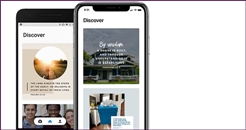 Pitching the Bible to the online generation
Pitching the Bible to the online generation
Over the last 20 years, so much has changed. How we converse - changed. How we buy - changed. How we commute - changed. How we eat - changed. How we read - changed. How we work - changed. How we stay informed - changed. All for better and for worse.
If you were a missionary landing on UK, European or US shores today and exegeting the culture, how would you communicate the gospel today?
Brian Chung, living in Los Angeles, in his early twenties and recently converted to Christianity found it was hard to read scripture despite being eager to do so. The text was small and serious-looking, each line corralled inside densely packed, numbered columns devoid of imagery. Inside, the pages were toilet-paper thin. Outside, the cover was solid black and intimidating.
For a person who is part of a generation shaped by an unending stream of visual content and social media stimulation, he felt this was not good design. So he founded a start-up, Alabaster Co., which places the full New Living Translation text of a biblical book inside publications that resemble chic, indie lifestyle and design magazines, like those you might find on a fashionable friend’s coffee table.
In their second year, Alabaster sold about 10,000 books and are forecasting a large increase in sales going forward. Their customers are primarily women, 21 to 35 years old who are city-dwellers.
Then there is Simon Pillario. He's been creating the Word for Word Bible Comic full-time since he completed a first successful Kickstarter in 2014. He's already completed four graphic books including the Gospel of Mark and is now working on the Book of Esther.
Watch this 2 minute video:
What about the Bible App? Already installed on over 365 million unique devices all over the world, the Bible App offers a free Bible experience for smartphones, tablets, and online at Bible.com. Partners make it possible for them to offer 1,884 Bible versions in 1,291 languages for free, and without advertising and the Bible App’s interface is available in more than 50 languages.
For the Instagram/Facebook generation, there is YouVersion's Bible Lens app that transforms your everyday photos into profound, Biblically-based artistic shareable images. Bible Lens lets you take a picture, or point to one you already have. It detects not only objects in your photo, but more importantly, the Biblical themes of the moment that photo captured… and then suggests Bible verses to match.
Why go to the Holy Land when you can tour it via a virtual reality (VR) headset in 3-D? An extension of the Bible app is a VR Bible study which features a walk through of the last few days of Jesus leading up to the crucifixion and resurrection. Produced by a film production company, the Octogon Project uses a 360-degree virtual reality camera that literally walks the viewer through the 7 Stations of the Cross, the Via Dolorosa and the Mount of Olives. .
Over the past 2,000 years, the way the Bible has been communicated has been reimagined and reinterpreted to reach a new audience. Pioneers are now making the Bible more accessible and attractive to a generation shaped by an unending stream of visual content and social media stimulation.
How is your church encouraging these ways to engage with the Bible?
Retweet about this article:
Geoff Knott, 16/04/2019